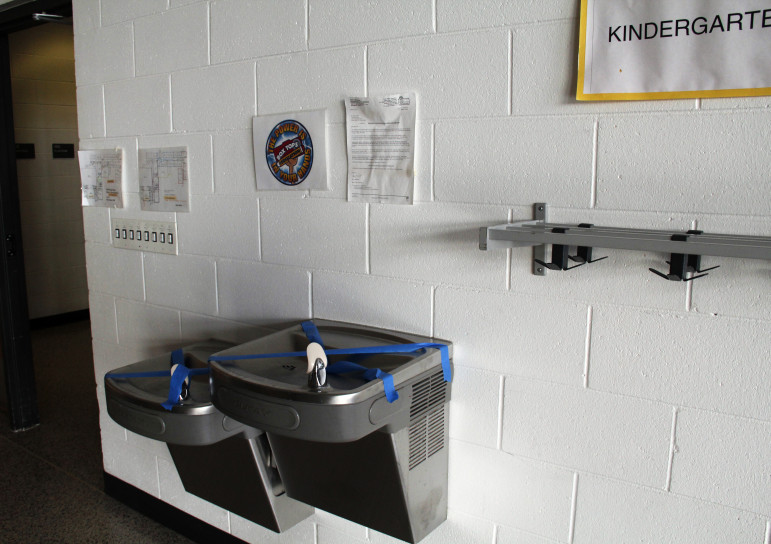Ruling Could Pollute Drinking Water State-Wide
EPA opens door to reuse of coal ash, despite evidence it's contaminating wells in Wisconsin.
Study links pollution, ash
Cook’s group found that, of the 1,000 wells studied in southeastern Wisconsin, 45 percent showed levels above the DNR enforcement standard of 40 parts per billion, and of those about half also tested above the state health standard of 90 ppb. The Wisconsin Department of Health advises that water with levels at or above 90 ppb not be used for drinking or cooking.
The closer the wells were to coal ash reuse sites, the higher the molybdenum levels, according to the study. The same was true of arsenic.
The DNR disputes the report’s findings, noting “significant shortcomings” in a formal response. Coakley said the Clean Wisconsin study relied on too little data from too large an area to definitively blame coal ash.
“The department does not concur that there is a clear correlation between the elevated molybdenum in groundwater in southeast Wisconsin and the beneficial use of ash from coal-fired power plants,” said the agency’s response to Cook and Clean Wisconsin.
In 2013, the DNR investigated molybdenum contamination in 24 area wells but found evidence linking the pollution to coal ash “inconclusive.”
State not tracking fate of ash
Record keeping for beneficial reuse is spotty, so it is unclear how much Wisconsin ash has been disposed of in loose form. The state does not require coal-burning utilities to disclose where and how they beneficially reuse much of their coal ash. Plus, what records of disposal activity do exist are not around long; Steve Kraus, a spokesman for Madison Gas & Electric, said utilities are only required to keep records for five years.
The Clean Wisconsin report cited studies from the EPA and elsewhere that showed, nationwide, more than 26 million tons of coal ash was disposed of in unencapsulated form in 2012.
Coakley said the DNR does not keep records on whether reused coal ash is encapsulated or loose at specific sites.

Water fountains are taped over at Yorkville Elementary School in Racine County due to high levels of the metal molybdenum. Clean Wisconsin alleges that coal ash buried in a school construction site is partly to blame. Photo by Cole Monka / Wisconsin Center for Investigative Journalism.
A school with bad water
Loose fill may be connected with undrinkable water at the Yorkville Elementary School in Racine County, according to the Clean Wisconsin report.
School District Administrator David Alexander said the DNR asked the school to test its well water in 2013. Those tests turned up high levels of molybdenum — 138 parts per billion, above the state’s 90 ppb health advisory level. The EPA says children should not drink water for even a single day from wells with more than 80 ppb of molybdenum.
Now, water fountains at the school are criss-crossed by blue tape to keep students from using them. Alexander said it costs about $8,500 a year for the district to supply the school with bottled water. Culligan water coolers are placed in the hallways. Tap water is not used to prepare food in the kitchen.
“It seems like you’d have to drink liters and liters and liters per day in order for it to cause much of a health concern at the concentrations that we have here, but nonetheless, we’ve just decided it’s the prudent thing to do.” Alexander said.
-
Wisconsin Lacks Clear System for Tracking Police Caught Lying
 May 9th, 2024 by Jacob Resneck
May 9th, 2024 by Jacob Resneck
-
Voters With Disabilities Demand Electronic Voting Option
 Apr 18th, 2024 by Alexander Shur
Apr 18th, 2024 by Alexander Shur
-
Few SNAP Recipients Reimbursed for Spoiled Food
 Apr 9th, 2024 by Addie Costello
Apr 9th, 2024 by Addie Costello





















There may be many wells that have elevated levels of contaminants, but based on the maps provided in the article, there doesn’t appear to be a correlation between locations of Beneficial Reuse of coal ash and the wells that showed elevated levels of the contaminants. Plus you should at least display the maps at the same scale.
Yeah, I don’t want to rule out coal ash as a possible cause for these contaminated wells, but the correlation is weak at best. Where’s the map showing, say, historic fill sites in relation to contaminated wells? Or historic dumps? Or salvage yards? Or industrial facilities? Or, heck, at naturally occurring mineral deposits?
Now, I agree that more study should be performed. The lack of funding to the WDNR for this specific problem is a failure of government.
I’d argue not that we should do nothing, but that it’s premature to point the finger solely at coal ash.
I wouldn’t say it’s a failure of government, it’s a failure of politics. The job can be done by government but the voters aren’t holding the state government accountable for this.
We get what we deserve.
Politics or government, I agree that the voters need to make their voices heard on the issue. If I have well issues, I’m calling my government representative and make sure I get heard.
That said, repeating those maps above uncritically, does a disservice to a complicated issue. At the very least, you need to separate out the use of coal ash in concrete and asphalt, where it presumably doesn’t leach, from its use as a soil amendment. That’s a flat out basic error that calls into question the whole methodology of the study.
Really, to me it’s looks like they’re trying to fit the facts to a predetermined conclusion. It doesn’t mean they’re wrong, but correlation doesn’t equal causation and even the correlation is not conclusive. The starting point is the wells and an investigation tracing contamination back to a source, not trying to jump ahead and skip the investigation step.
I spent decades collecting well samples for analysis from around coal ash sites and other contaminated property locations. The map above shows there really is little correlation between the ash sites and well contamination problems. Sources could also be old leaky well linings that were never sealed properly and surface water runoff contaminates the well. The source could also be a background level.
There are many pre-1980 fill sites where materials were dumped to fill in a wetland and low area including along major waterways. The materials included foundry sand, incinerator ash, garbage, industrial liquid waste, etc. Milwaukee’s Menomonee Valley and Downtown area included over 1,000 acres of filled properties with humans’ waste debris with layers up to 20-30 feet deep. Many farms had there own private dump sites and allowed industry to fill things on their properties. Southeast Wisconsin was an industrial giant at one time and the buried waste pockets litter the country-side that could be potential sources of well contamination.
A lot more detailed investigation is needed. Regulated landfills are an easy target since we already know they are there but they have also been monitored and designed with best practices. All the unknown sites are really undiscovered and have no monitoring history or identification of the waste product.
Coal was in heavy use as the fuel of choice till the 1960s. Coal ash was spread on roads for de-icing before the start of salting, another toxic material. Homes also used coal for heating and ashes were likely spread on the property. During the 50s and 60s, you could smell the acrid odor of coal burning during the winter times and the snow would turn black with soot after a few days.